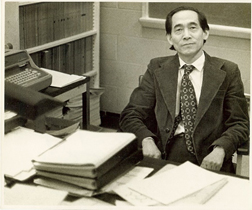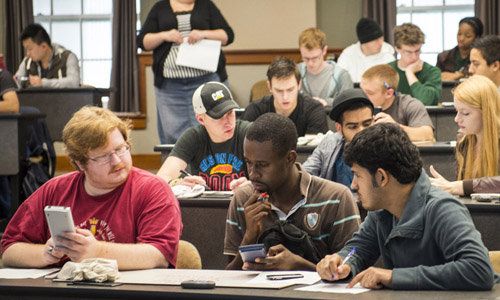By Jean Andrews
Physics & Astronomy
Dr. Tomoyasu Tanaka, age 94, Emeritus Professor of Physics at Ohio University, passed away in May in his native Japan. He was a highly respected theoretical physicist, loving parent to five children, husband, and son.
“Professor Tanaka was a wonderful colleague. He was interesting to talk to and a very good teacher at the undergraduate and graduate level,” said Dr. Louis Wright, Emeritus Professor of Physics and Department Chair during the 1990s. “Soon after joining the faculty at Ohio University, Tomo and his old friend and colleague Professor Katsumori of the Chubu Institute of Technology in Nagoya City initiated an exchange program with Ohio University and Chubu.”
“I had the pleasure of being the second Chubu Visiting Professor in the Spring of 1975,” Wright continued. “This was a typical idea of Tomo. He was always interested in trying out new options to improve higher education and open up possibilities for students and faculty. The exchange program with the now Chubu University and Ohio University continues to be strong to this day. Every spring we’re reminded of this exchange when we see the 175 cherry trees in bloom that Chubu University gave to Ohio University to celebrate its 175th birthday in 1979, and the additional 25 trees received as a gift last spring to commemorate Ohio University’s 200th year.”
Thesis Adviser to Future Nobel Laureate
Tanaka was a member of the Physics & Astronomy faculty from 1971 to 1989. He taught Statistical Mechanics and Solid State Theory, among other courses. He was well-known for his excellent teaching at both undergraduate and graduate levels and for his supervision of students in the many-body theoretical group, the solid-state experimental group, and the acoustics experimental group. One of his six graduate students, Venkatraman “Venki” Ramakrishnan, received his Ph.D. in 1976 in condensed matter theory, and later was one of three scientists awarded the 2009 Nobel Prize in Chemistry for his work on the structure of the ribosome.
Tanaka obtained his master’s degree in 1943 at Kyushu Imperial University, and in 1953 his doctorate in science at the same university. In 1948 he was appointed assistant professor in the Faculty of Science, Department of Physics, Kyushu University, Fukuoka, Japan. In 1954 he obtained a Fulbright Act Grant and a Smith-Mundt Act Grant to travel to and stay in the United States at the Enrico Fermi Institute for Nuclear Studies, University of Chicago as a Research Associate under Professor J.E. Mayer. In 1955, his stay in the United States was extended for one year, and he became a Research Associate in Fluid Dynamics and Applied Mathematics at the University of Maryland. He returned to Japan in 1956, and was promoted to full professor at his home university. In 1960, The Catholic University of America, Washington, DC, appointed him Professor of Physics, whereupon he left Japan semi-permanently to continue his research in the United States.
He was a member of the Physical Society of Japan (since 1945) and of the American Physical Society (since 1954.) He acted as one of the Board of Editors of the Physical Society of Japan for seven years; he was twice a member of the National Committee on Programming in the Research in Theoretical Physics at the Research Institute for Fundamental Physics at Kyoto University.
Tanaka remained active in retirement by returning to Athens during the Fall of 1997 to write Methods of Statistical Physics, a graduate-level thermophysics textbook, published by Cambridge University Press in 2002. The book includes chapters on traditional ensemble theory, review of representation theory, second quantization, perturbation theory, cluster variation method, spin-wave theory, BCS, and s-d interaction.
A Witness to the Atomic Bombing of Hiroshima
Tanaka grew up in Japan and was drafted to serve his country during the World War II. His recollections of that time were stark and horrific. Tanaka’s daughter, Norico, recalled, “My father was serving as a naval officer and instructor at the Japanese Imperial Naval Academy on an island near Hiroshima on the day of the bombing. He never spoke in detail about this experience to any of us. At 8:15 that morning, he was brushing his teeth and getting ready for class when the flash came. The instructors were requested to analyze the bomb, and knowing it could not be TNT because no plane could carry a TNT bomb of that size, they concluded it was the “new-model bomb” that had been rumored to be under development,” she said.
“From his memoirs,” Norico continued, “He wrote: On that fateful day of August 6, 1945, I was witness to the bomb’s flash, followed by the shock wave, then the mushroom cloud—from an island just 15 km across the bay from Hiroshima. I cannot find the words to express what I saw, only that I pray deeply that never again will such a tragedy happen again on this earth.”
“After another bomb was dropped on Nagasaki, the war quickly came to an end. My father sent all the young soldiers home, closed down the school and passed through the city of Hiroshima on his way back to Tokyo. My mother says he later said he saw bodies everywhere, and injured people with severe burns with skin hanging from their bodies. He walked along the railroad tracks until he got to a station where the trains were still running, and returned to Tokyo,” she said.
An Advocate for International Understanding
Tanaka moved back to Nagoya City, Japan after having lived in the United States for almost thirty years, to take up a professorship in the Department of Industrial Physics at Chubu. From 1984, Tanaka served for thirteen years as the director at the Center for International Programs. He was subsequently appointed the senior university advisor until 2002. In the meantime, he continued to teach for part of the year at Ohio University, splitting his time between Nagoya and Athens. He was subsequently appointed Emeritus Professor at the two universities.
As the inaugural director for the Center for International Affairs, he wrote in the Chubu newsletter in 1985: “…To be ‘international,’ we must forget the national boundaries that divide us, and live together as citizens of a global world. We must rid ourselves of stereotypes, feelings of superiority and/or inferiority, respect others, and live together as companions in a contemporary world. To do that, we must strive to expand our horizons.”
Also in his memoirs, he wrote about the places he had lived, “As one advances in age, it’s nice to be back in one’s home country. I spent 28 years with my family in the U.S. and acquired a permanent visa, but never citizenship. America is my second home, and will forever be dear to my heart.”
He is survived by his wife of 66 years, Sumiko Suzuki Tanaka of Tsuchiura City; three sons, Minoru Tanaka of Tsuchiura City, Jiro Tanaka and wife Yoshiko of Saitama City, Tim Tanaka of Raleigh, NC; two daughters, Hiroko Tanaka Minamikata of Colchester, England, and husband Satoshi of Tokyo, and Norico Tanaka Wada of Tokyo; and a granddaughter Noe Minamikata of London.




















Comments